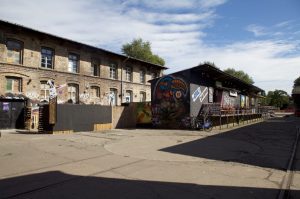Once an unattractive place, formerly on the East-West border and at the periphery of public discourse, it has recently become an area of new interest for different social groups. Over the years it has welcomed a mainly Turkish community, but now young people from all over Europe are attracted to Neukölln by its affordable rents, and new bars, art galleries and trendy shops are appearing. However, rents are increasing dramatically, and Neukölln is showing signs of gentrification, which raises debates about the future of the district and its low-income inhabitants.
The neighborhood got its name from the historic Körnerpark, which offers a delightful spot for citizens and tourists to enjoy the summer in Berlin, attend cultural events, watch open-air movies, or engage with art initiatives. Nevertheless, the area surrounding the park is defined by a completely different reputation, at least among local residents. The historical trajectory of development followed by the neighborhood resembled that of a disadvantaged place: located in the northern part of Berlin Neukölln, the borderline territory of Körnerkietz was largely ignored during the German division due to its proximity to the Wall, perceived as a dangerous and suburban zone.
After the Unification, the lack of investments and social interests in the area turned it into an attractive and convenient destination for a novel population of migrants, who could easily settle there due to the presence of relatively lower rents and a reduced cost of living. Indeed, available demographics related to Körnerkietz reveal that around 60% of its residents are immigrants or have a migration background, mainly from Turkey or Arabic countries. Many families are characterized by low-skilled and low-educated providers and the number of non-German-speaking children in childcare facilities represents a challenge for the successful integration of different cultures within this multi-ethnic neighborhood. Such demographic composition, combined with the poor conditions of educational and commercial infrastructures and the insufficient supply of public recreational facilities, might easily trigger the latent potential for outbursts of social conflicts and set low-quality living standards for the people in the neighborhood.
As was the case for Mehringplatz, the Körnerkiez has been included in the list of socially deprived neighborhoods and targeted with a set of policy measures to counteract the downward spiral of inequalities by targeting issues related to youth training and education, employment, and cultural integration. More specifically, Körnerkiez took part in the social cohesion program implemented and funded by the “Soziale Stadt” (Social City), in joint cooperation with other state actors, including the Senate Department for Urban Development and the Neukölln District Office.
In 2005, as part of the initiatives promoted by the Soziale Stadt, a Körnerpark Neighborhood Management was established as an empowering tool through which the community is given the opportunity to discover itself as such while being assigned the responsibility to actively deliberate on issues concerning their neighborhood. Residents are allowed to participate in decision-making processes in an environment that invites them to openly communicate their ideas and share their knowledge as local experts of the urban area in which they live. In this way, networking dynamics are set off prompting the communal creation of a shared social identity and the acknowledgment of a sense of agency stemming from these participatory activities, signaling that residents’ voice matters. For example, residents encounter business owners, educational actors, and cultural entrepreneurs to debate how to effectively allocate grants in order to respond to the needs and desires of the local inhabitants of Körnerkietz.
Notwithstanding the many steps taken to mobilize people and improve social stability in their neighborhood, Körnerkietz has still several challenges to overcome, as new issues have started to emerge. Some are the early signs of gentrification, as these forces are already pushing in and reshaping Neukölln as a trendy and culturally vibrant district, with all the related risks in terms of rental costs and population displacements. On the other hand, the low amount of adequate care facilities has made drug-related problems more visible in an area that is bordering the lively scene of Berlin’s clubbing life and it has considerably affected the public use of space by local residents.
Tesserae selected Körnerkietz as a case study within the analytical framework set up by the European Commission’s Directorate-General for Regional and Urban Policy (DG REGIO) and the “Urban Development in the EU” program (2007-2013). The project was part of a series of studies that aimed to investigate good practices of urban development carried out in several European cities, in order to design tools capable of providing adequate guidance to future policies of social cohesion.
Further information can be found:
DE-Berlin_Körnerkiez_JA_061212


